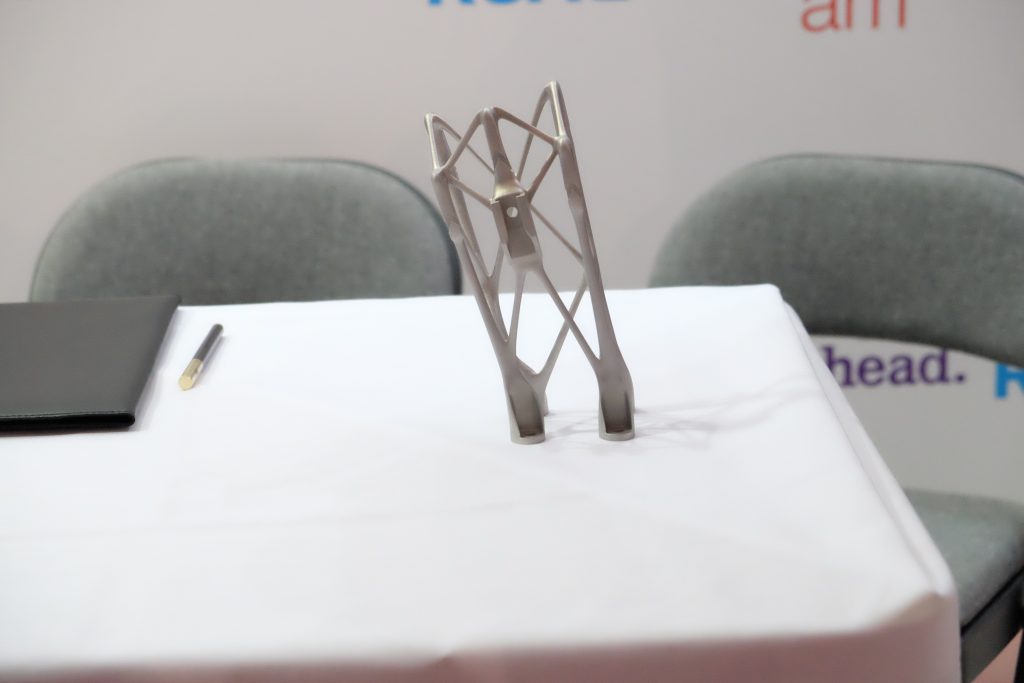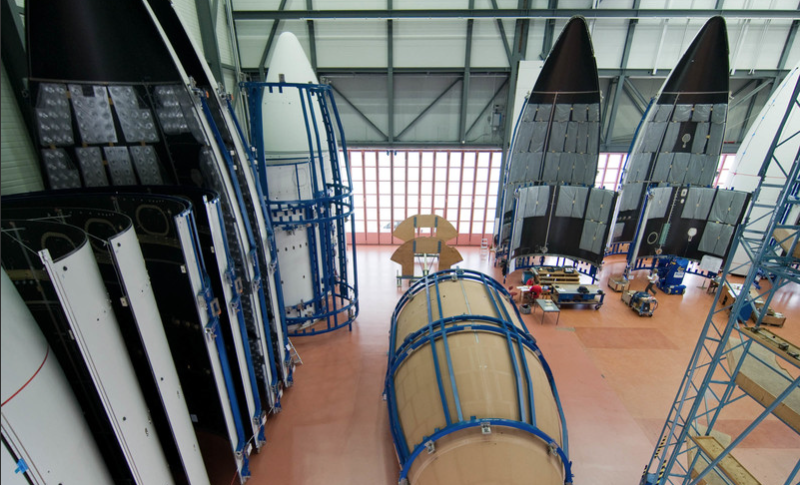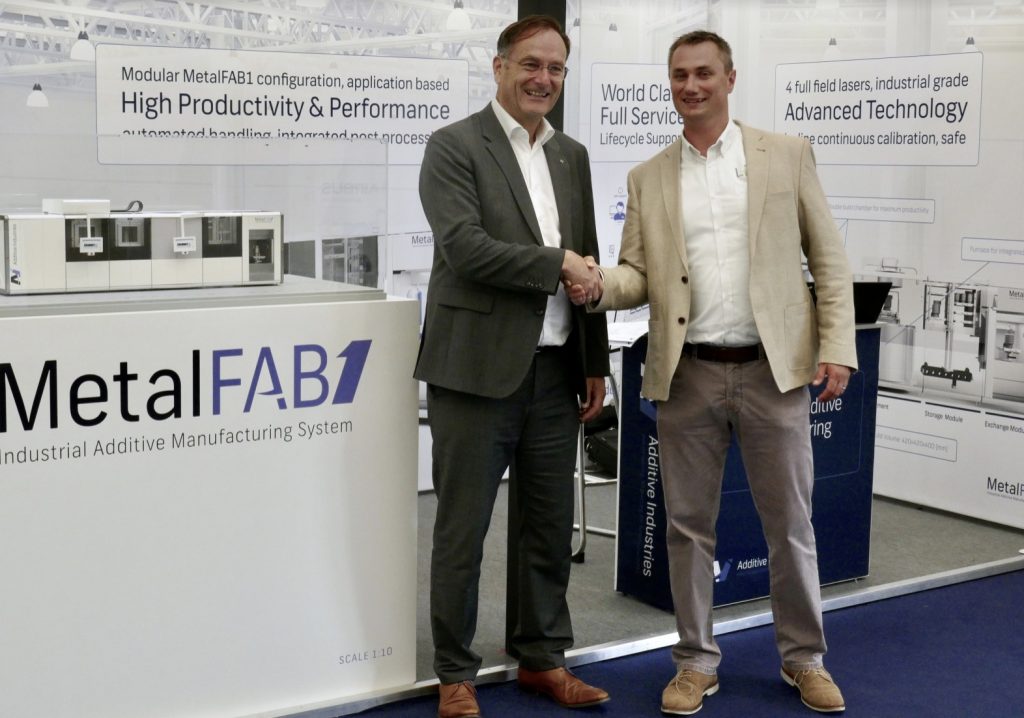Mayday, Farnborough, we’re running out of champagne.

The 3D printed fairing bracket made by RUAG and Oerlikon.
If you’re slowly but surely getting the impression that a lot of deals are being signed at the Farnborough Airshow, you would be right. Amidst the clash of Airbus and Boeing to land big orders and make an impression it is now de rigeur to sign a deal of some kind at Farnborough.
The show is one of the yearly game of one-upmanship of Boeing and Airbus. It also sees a lot of demonstrations and novelties in aviation, including this incredible display with a C130. There’s always far out stuff such as talk of balloons with 46 meter long cabins taking people on tours around the world and tiny robots that would crawl across engines to repair them (which I believe is much more likely to happen). There are always surprisingly large orders from surprisingly unknown airlines. This year Vietjet inked a deal for $12 billion to purchase a 100 737 Max Jets. That’s one deal, that is approximately the size of our total industry revenue. Everything in 3D Printing, all of the materials used, all of the machines sold, all of the software, everything. Smaller than one deal inked at Farnborough by a Vietnamese Airline. Puts things into perspective, doesn’t it?
A big portion of our future lies at Farnborough though. Don’t expect us to make the BBC headlines any time soon there but an important shift is happening. Quietly, we’re moving into production. Serial production and manufacturing in metals has been with us for a number of years with millions of parts being produced for dental and tens of thousands for prosthetics. The renderings of 3D printed metal aviation components have been flying around more than the components, but a fundamental shift is occurring towards actual manufacturing in aircraft. So far test brackets, unique parts, retrofits and the like saw metal 3D printed parts. EBM and DMLS have been used extensively in rockets and on satellites. Now companies are taking the necessary steps into manufacturing tens of thousands of aviation components. For aviation, this means a lot of qualification and certification which is a significant investment for people wanting to serve the aviation and space industries. We saw two important 3D printing tie-ups recently, along with all the matchmaking GE was doing as well. The first tie-up is “the Swiss space program” while the other is “anglo dutch powder.”
Oerlikon
Oerlikon is a Swiss company that makes fibres, drive systems and surface solutions. It is a multibillion-dollar company and makes over $20 million a year in 3D printing chiefly through metal fabrication. The company will be investing over $100 million in 3D printing in the coming years.
RUAG Space
RUAG is also Swiss. RUAG space is one of the largest Europe based space firms. RUAG Space makes satellite components, launchers and electronics components for onboard spacecraft. Far away from the profligate spending on American satellites by the NRO (National Reconnaissance Office, $10 billion budget us agency in charge of the US’s spy satellites) and a bit separate from its more European counterparts RUAG simply needed to get good.

Oerlikon and RUAG partner to make products like the serially produced space bracket.
RUAG Space and Oerlikon signed a Memorandum of Understanding to facilitate the series production of space components. The companies are working together on a bracket for a payload fairing. Payload fairing might sound cute but below you can see a picture of a payload fairing, pay close attention to the desk with the men in the red shirts. Its essentially a nose cone part for a rocket, and they’re working on a bracket for this.

A room with fairings in EMMEN at RUAG
The companies are seeing that the bracket “25 percent and decrease weight by more than 50 percent while doubling the stiffness of the bracket.” The fact that we can create higher performance 3D printed parts than conventional ones is of course interesting. In rocketry and satellites each kilo saved may save them $20,000 or more with additional gains in performance. Dr. Roland Fischer, CEO of Oerlikon Group stated,
“Through our ongoing collaboration with RUAG Space, we have identified opportunities to fine-tune the qualification and certification processes, which are crucial in ensuring consistent quality in production. We are confident, that our materials and additive manufacturing expertise will further grow this important partnership.”The consistent quality will certainly be important for space. Certification may seem boring but in this case, means that many millions have gone into reducing the errors in 3D printing.
In another article, the CEO stated that, “
“It is not good enough that everyone does something a little different,” Fischer said. “We are talking about aerospace, where failure is not an option.” 3D printing today is like driving a car in 1905, he said. There were different automakers, but no certification processes, no standards, and not even established road signs.”
This candor and humility will surely complement their lofty ambitions well.
Additive Industries and LPW

At Farnborough with Phil Carroll and Jan-Cees Santema
Another pair with lofty ambitions is Dutch-based Additive Industries and UK company LPW Technology. Additive Industries has from the ground up designed a metal 3D printer for manufacturing. The company minimized handling through automation and designed a system meant for high reproducibility and series production that could simultaneously reduce the cost of parts. Essentially their modular system means that rather than an operator turning on and off the machine and carrying build platforms to various steps, the machine handles this; significantly reducing handling and cost.
LPW Technology is a powder company that develops custom powders independently of machine manufacturers. It also is big on managing and tracking the powder throughout its use. This is precisely the kind of thing that has to be done if one were to make aerospace components.
Their agreement lets LPW offer its powder management products to MetalFAB1 customers through Additive Industries Additive World Platform.
“This allows Additive Industries customers to automatically load powder into the MetalFAB1 systems in
inert conditions and record the main characteristics of the metal powders during their lifecycle from
metal powder manufacturing to part production. Especially in series production of qualified parts,
this closed-loop system is key in reducing the risk of contamination and potential variations in the
powder performance as a result of exposure to oxygen and humidity.”
More control and fewer variables mean that mistakes can be found and tracked while quality is more likely to occur.
Daan Kersten CEO of Additive Industries said,
“We have been working with LPW for years and share the vision on full automation and integration. Integrating the
LPW Powder Hopper solution and PowderSolve software in our MetalFAB1 systems and software allow our customers to accelerate the manufacturing of industrial quality parts and store all data in one place. The integrated supply of powder combined with full traceability closes the loop to produce certified parts in regulated environments like aerospace and healthcare. Moreover, the automated and closed powder loading system cuts manual labour significantly and reduces operator exposure to powder providing a safe and healthy work environment. The long-term relationship between LPW Technology and Additive Industries has resulted into this innovative powder handling
System”.
Additive Industries tends to collaborate also working with 3DSim simulation software and also working with GKN Powder an LPW competitor. If Additive Industries, LPW, RUAG and OERLIKON four just got together with a software company, they would have most of the supply chain for making space parts. In order to impress the huge space industry we’ll have quite a ways to go, but perhaps one or two Airbus or Boeing people wiggled their noses post champagne bubble long enough to squint at the future of their industry.
Subscribe to Our Email Newsletter
Stay up-to-date on all the latest news from the 3D printing industry and receive information and offers from third party vendors.
You May Also Like
Gorilla Sports GE’s First 3D Printed Titanium Cast
How do you help a gorilla with a broken arm? Sounds like the start of a bad joke a zookeeper might tell, but it’s an actual dilemma recently faced by...
Nylon 3D Printed Parts Made More Functional with Coatings & Colors
Parts 3D printed from polyamide (PA, Nylon) 12 using powder bed fusion (PBF) are a mainstay in the additive manufacturing (AM) industry. While post-finishing processes have improved the porosity of...
$25M to Back Sintavia’s Largest Expansion of Metal 3D Printing Capacity Since 2019
Sintavia, the digital manufacturing company specializing in mission-critical parts for strategic sectors, announced a $25 million investment to increase its production capacity, the largest expansion to its operations since 2019....
Velo3D Initiates Public Offering in a Bid to Strengthen Financial Foundations and Drive Future Growth
Velo3D (NYSE: VLD) has been among a number of publicly traded 3D printing firms that have attempted to weather the current macroeconomic climate. After posting a challenging financial report for 2023,...































